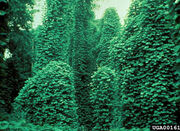
Wild Jumping Carp On Illinois River-0

An invasive species is defined by the United States Department of Agriculture (USDA, 2012) as a species that is “non-native (or alien) to the ecosystem under consideration and whose introduction causes or is likely to cause economic or environmental harm or harm to human health.” Invasive species can be plants, animals and other organisms such as bacteria, viruses or other microbes. For millions of years, the Earth has had natural barriers for the majority of species (Lowe et al., 2000). Therefore, human actions are the primary means of invasive species introductions (Lowe et al., 2000; USDA, 2012). And despite many instances of species introductions gone awry, the introduction of invasive species in new habitats continues to problem whether intentional or accidental (Lowe et al, 2000). The list provided by Lowe et al. (2000) in the “100 of the World’s Worst Invasive Species” is not all-encompassing. However, the list provides as interesting look at some of the most significant invasions.
Native vs, Non-native[]
Some invasive native species are more destructive that ‘non-native’ species. We have learned these lessons from all the past ecology restoration attempts whether they were fails or successes (Davis, 2011).
==Sea Lamprey ==
The Sea Lamprey in the Great Lakes preys on fish that humans eat like lake trout. This problem has been mostly under control since the late 1970’s, however, the lampreys still kill many fish species throughout the Great Lakes. The tool being used to mitigate the problem is a pheromone that mimics the smell of dead juveniles from their own species. They are adapted to avoid areas with this pheromone so it serves as an effective tool without using greatly affecting other animals or plants that share the same waters. As Messing and Wright (2006) put it, “These attempts have brought knowledge that should be used, applied and learned from. While new principals emerge federal regulation should be established that is efficient, rational, transparent, accountable, and ecologically meaningful.”
The Asian Carp, Silver Carp, are an invasive species that are living in the Mississippi River and its tributaries. When a boat come by, it jumps out of the water, creating a big hazard to passing boaters. See the video for an example.
References[]
Davis, M., Chew, M., Hobbs, R., Lugo, A., Ewel, J., Vermeij, G., & ... Briggs, J. (2011). Don't judge species on their origins. Nature, 474(7350), 153-154.
Lowe, S., Browne, M., Boudjelas, S., & De Poorter, M. (2000). 100 of the world's worst
invasive alien species: a selection from the global invasive species database. Auckland, New Zealand: Invasive Species Specialist Group.
United States Department of Agriculture (USDA). (2012). What is an invasive species? Retrieved on November 30, 2013 from http://www.invasivespeciesinfo.gov/whatis.shtml.
Messing, R. H. & Wright, M.G. (2006) Biological control of invasive species: solution or pollution? Frontiers in Ecology and the Environment, 4(3), 132-140.